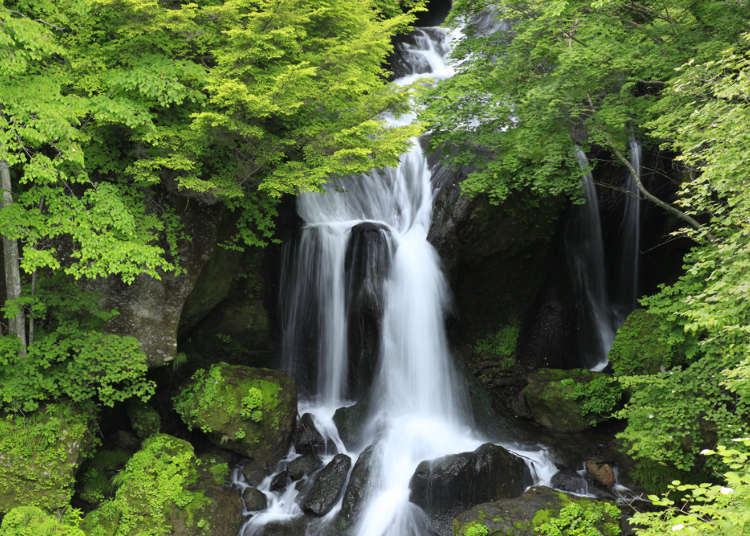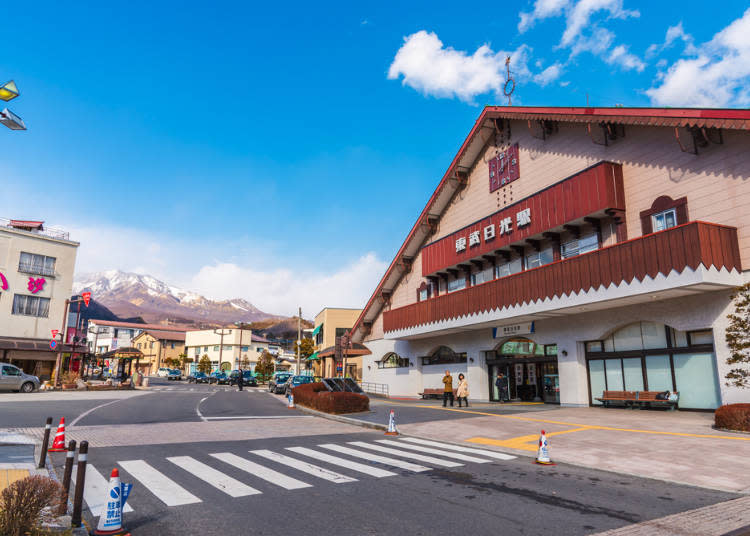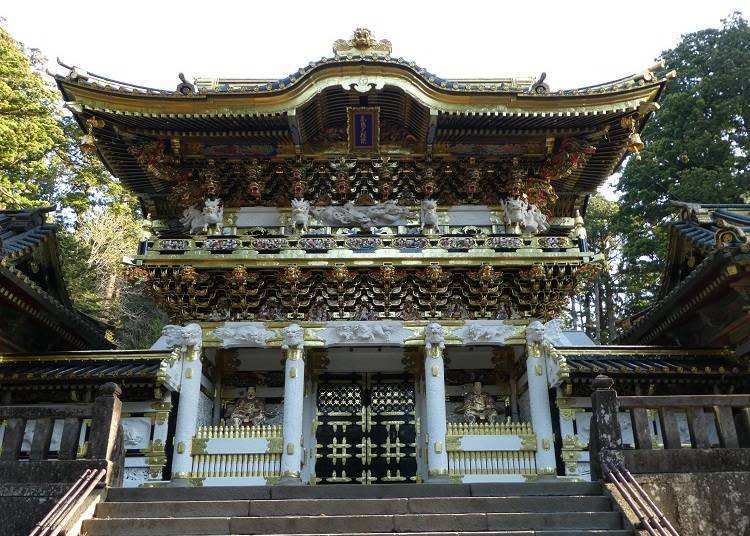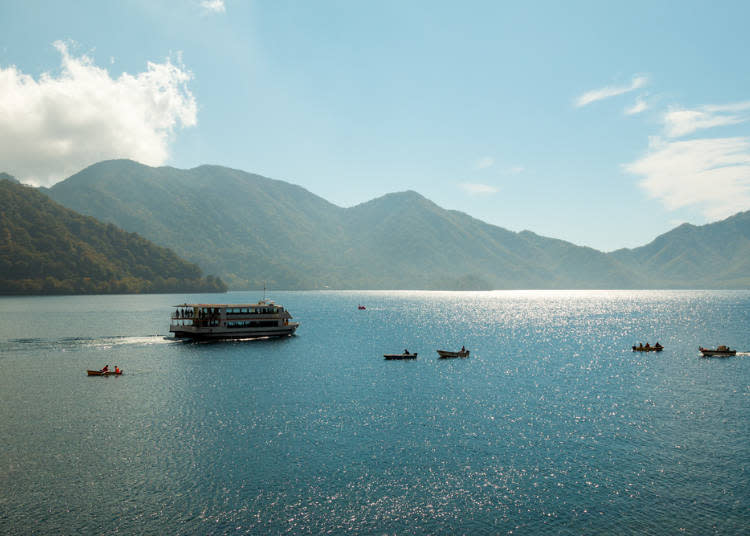Nikko Japan Guide: Recommended Day-Trip Itinerary and One-Night Stays (+Free Pass Information)

Nikko is home to a number of shrines and temples that are registered as World Heritage Sites and is without question one of the most popular tourism sites in the world. Not only is this a place where you can feel Japan's history and culture, but also find comfort in the soothing grandeur of nature and the hot springs which are visited by so many. There are lots of sights to enjoy throughout the year, but the transition from autumn to winter is exceptionally beautiful, especially when the foliage turns to bright reds and yellows between mid-October and early November painting the surrounding mountains in brilliant fall foliage.
In this article we will introduce two ways to visit Nikko, located just under two hours from Asakusa, Tokyo by express train; one being a day trip and the other a two-day trip with an overnight stay.
Recommended Day-trip Course: Designed to take in all the standard sightseeing spots in the shortest time possible
When you visit Nikko by train you will arrive at either the JR Nikko Station or the Tobu Nikko Station and these will be the starting point for visiting the major sightseeing spots and experiencing the charms of Nikko in a timely manner.
● Tobu Nikko Station

Torjrtrx / Shutterstock.com
Begin by visiting the Nikko Concierge located in the Tobu Nikko Station Tourist Center, where the staff can also speak English, in order to get information before setting out (JR Nikko Station is only a few minutes' walk away).
↓
● Nikko Toshogu

©日光東照宮
We will begin by visiting the Nikko Toshogu World Heritage Site that is the main tourist attraction in Nikko. Here stunning, colorful and impressive carvings showcase the techniques of Edo period craftsmen. Don't miss the carvings of animals, such as the three monkeys said to be admonishing mankind, and sleeping cat, as well as ornate buildings and a five-storied pagoda that are national treasures and important cultural properties.
↓
● Iroha Saka

Connecting Nikko City and Lake Chuzenji is a sightseeing road with 48 curves going up and down. The Japanese syllabary consists of 48 characters referred to as "Iroha" and as the road on this hill consists of 48 curves it has been called the Iroha Saka [hill]. It is a popular course for drives as it offers spectacular views of the autumn leaves in the fall.
↓
● Kegon Falls

Kegon Falls are one of the three most famous waterfalls in Japan. The water flowing from Lake Chuzenji falls with a roar from a height of 97 meters. To experience the full power of the waterfall, take the elevator to the viewing platform at the base of the falls where you can view them up close.
↓
● Lake Chuzenji

Lake Chuzenji was created about 20,000 years ago when Mt. Nantai erupted and showcases the natural beauty of the area throughout the four seasons. The brilliant colors of the autumn leaves contrasting with the lake are especially beautiful. The lake sits at an elevation of 1,200 meters so it is the perfect place to go to escape the summer heat. Take a short walk along the shore of the lake to better experience the gorgeous scenery.
↓
● Shinkyo Bridge

On the way back to Nikko Station, let's take a look at the sacred bridge at the entrance to Mt. Nikko. Shinkyo, which is registered as a World Heritage site, is a bright, vermilion wooden bridge. The bridge in contrast with the trees during those seasons when the leaves are bright green or dazzling fall colors, evokes a deep sense of awe.
↓
● Monzencho

Anak Surasarang / Shutterstock.com
The main area of Nikko City is situated along the main street that goes from Shinkyo Bridge to Tobu Nikko Station. Here you will find local dishes and specialties such as yuba [tofu skin] and traditional sweets like yokan [sweet bean jelly] along with Nikko-style carvings which always make popular souvenirs. A leisurely walk through Monzencho admiring the well-known shops with long traditions will take you back towards Nikko Station.
↓
● Tobu and JR Nikko Stations
One Night, Two Days Course: Allows for a more leisurely visit and a chance to more fully immerse yourself in the great expanse of nature as well as enjoy the hot springs
While Nikko can be enjoyed on a day trip, spending a night there will enable you to relax in a hot spring and also take walks through the vast natural beauty surrounding it.
<Day One>
● Tobu Nikko Station and JR Nikko Station
↓
● Nikko Yamauchi
Nikko Yamauchi refers to the Nikko Toshogu, the Nikko Futarasan Shrine, said to be effective in matchmaking, and Nikkozan Rinnoji Temple which houses the Sanbutsudo, a building that contains three gold-leaf statues of Buddhist deities. The grounds of these two shrines and temple, all World Heritage Sites, are so large that it will take more than three hours to see them all.
・ Nikko Futarasan Shrine

cowardlion / Shutterstock.com
The precincts of Nikko Futarasan Shrine, the oldest structure in Nikko Yamauchi, are surrounded by large cedar trees, creating a mystical atmosphere. Those who seek to improve their fortunes come here as it is said that this place is noted for its beneficial effects on matchmaking and family harmony.
・Nikko Toshogu

This is a World Heritage site where you can enjoy the splendid architectural beauty created by Edo craftsmen. Within the precincts are national treasures and important cultural assets, and beautiful carvings can be seen everywhere.
・Nikkozan Rinnoji Temple

Leisurely admire the three 7.5-meter tall Buddhist statues in the eye-catching bright vermilion main hall of Nikkozan Rinnoji Temple. The precincts of Nikkozan Rinnoji Temple are designated as national historic sites and are also registered in the UNESCO World Heritage Site Shrines and Temples of Nikko.
↓
● Iroha Saka
↓
● Kegon Falls
↓
● Lake Chuzenji sightseeing boat

MENG KONGSAK / Shutterstock.com
You can enjoy Lake Chuzenji by either walking along its 25-kilometer shoreline or enjoying a cruise on the Swan Boat or a sightseeing craft. Sightseeing boats offer a course that takes you all around Lake Chuzenji. Enjoying the view of the azaleas in early summer and the autumn leaves in the fall from the lake makes for an especially memorable time.
↓
● Nikko Yumoto Onsen

A short distance from Lake Chuzenji there are inns in Nikko Yumoto Hot Springs that boast long histories where you can spend leisurely moments. In a quiet hot spring area in the mountains, you can enjoy white turbid sulfur hot springs.
Enjoy a relaxing stay, as though in a resort, at an inn near the shores of Lake Chuzenji.
Chuzenji Kanaya Hotel
<Day Two>
● Yudaki

Yudaki Falls flows out of Lake Yuno and cascades down a rocky cliff from a height of about 70 meters. Go down the stone steps to an observation platform at the base of the falls for a truly spectacular view.
↓
● Senjogahara

Senjogahara [literally "battlefield"] gets its name from a legend that this was where the gods of Mt. Nantai and Mt. Akagi fought each other for Lake Chuzenji. It is a vast marshland covering about 400 hectares. There is a nature exploration path encircling the marshland which can be hiked in about two hours. While enjoying this magnificent expanse of nature you can also observe the 350 kinds of plants and wild birds found here.
↓
● Tobu Nikko Station and JR Nikko Station
On your way back to the station from Shinkyo Bridge you can look for souvenirs as you walk through Monzencho.
Useful information! The Free Pass is highly recommended for visitors

cowardlion / Shutterstock.com
Visitors to Nikko usually begin their excursion from Nikko Station by taking buses to the places they want to see. There are several types of free passes from which to choose depending on your travel plans, so why not consider one of these?
● NIKKO PASS all area (Tobu Railway)
This free pass is recommended for foreigners visiting Japan who want to visit the World Heritage Sites, take a sightseeing cruise on Lake Chuzenji, and visit Yumoto Onsen from Tobu Nikko Station. In addition to train and bus discounts and unlimited rides, there are various discount benefits available in the Nikko area.
Cost:
(Summer April 20 ~ November 30) Adults 4,520 yen, children 1,150 yen
(Winter December 1 ~ April 19) Adults 4,150 yen, children 1,040 yen
Valid period: 4 days
Railway free use section: Shimo-Imaichi ~ Tobu Nikko and Shin-Fujiwara (including round trip between Asakusa Station and Shimo-Imaichi Station)
Bus and other free use section:
(Summer) Tobu Nikko Station ~ Yumoto Onsen, Kotoku Onsen, Ozasa Ranch, Kiyotaki ~ Oku Hosoo, Chuzenji Onsen ~ Tachiki Kannon-mae ~ Hangetsuyama, Yashio no Yu; World Heritage Sites Tour Bus; Nikko Kinugawa Line (operates only on days when SL Taiju runs), Lake Chuzenji cruise ships, Akechidaira Ropeway, Edo Village Loop-line Bus, Low Pollution Bus
(Winter) Tobu Nikko Station ~ Yumoto Onsen, Kotoku Onsen, Kirifuri no Taki Falls ~ Kiyotaki, Oku Hosoo, Yashio no Yu, World Heritage Tour Bus, Nikko Kinugawa Line (operates only on days when SL Taiju runs), Akechidaira Ropeway, Edo Village Lop-line Bus
NIKKO PASS all area - TOBU RAILWAY
● NIKKO PASS world heritage area (Tobu Railway)
This is perfect for foreigners visiting Japan who want to take a bus from Nikko Station and explore the Nikko Yamauchi area, where there are world heritage shrines and temples such as Nikko Toshogu Shrine, Nikko Futarasan Shrine and Nikkozan Rinnoji Temple. You can get on and off the World Heritage Tour Bus that runs in the Nikko Yamauchi area as many times as you like for two days.
Price: Adults 2,000 yen, children 600 yen
Valid period: 2 days
Railway free use section: Shimo-Imaichi ~ Tobu Nikko and Shin-Fujiwara (including round trip between Asakusa Station and Shimo-Imaichi Station)
Bus free use section: JR Nikko Station and Tobu Nikko Station ~ Rengeseki World Heritage Tour Bus
NIKKO PASS world heritage area - TOBU RAILWAY
● Other free passes
Chuzenji Onsen Free Pass (2,000 yen), Senjogahara Free Pass (2,650 yen), Yumoto Onsen Free Pass (3,000 yen), Kirifuri Kogen Free Pass (1,200 yen), Ozasa Ranch Free Pass (1,800 yen), Kirifuri no Taki Free Pass (600 yen *valid for the day only) allow you to get on and off the Tobu Bus within each applicable section as often as you like for two days. These are good for those wishing to leisurely enjoy such areas as Chuzenji Onsen and Senjogahara.
If you only want to explore the city center around Nikko Yamauchi, you should be able to do that just on a day trip. But if you plan on visiting Nikko, then we recommend considering a plan that would allow you to spend some time in Yumoto Onsen and the hot spring town. There are many types of lodging available in the area, so probably you should be able to find one that suits your needs. Whether you make a day trip or plan to spend a night and two days don’t forget to look into the free passes that can save you money.
Other free passes
*Information obtained in July 2019; some details may have changed in the time since.


